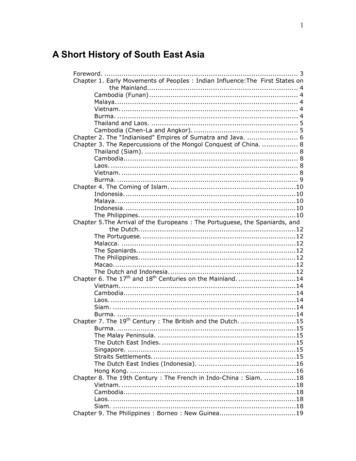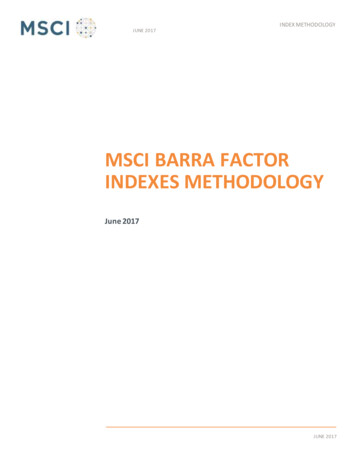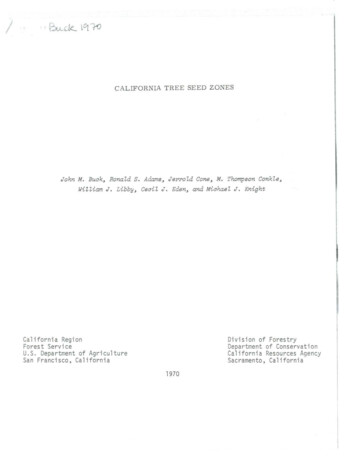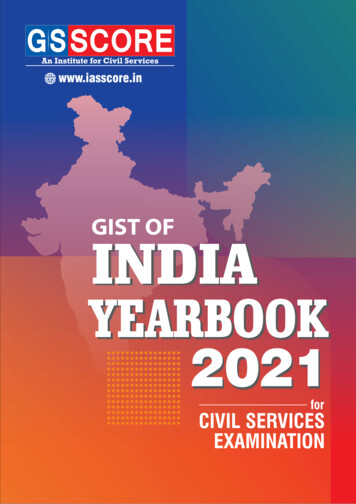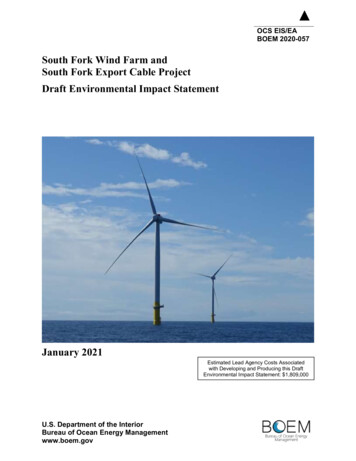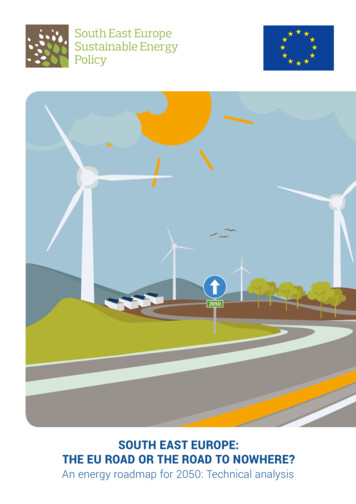
Transcription
2050SOUTH EAST EUROPE:THE EU ROAD OR THE ROAD TO NOWHERE?An energy roadmap for 2050: Technical analysis
SEE 2050 ENERGYMODELSEE 2050 CARBONCALCULATORJUNE 2016This publication has been produced with the assistanceof the European Union. The contents of this publicationare the sole responsibility of SEE Change Net on behalfof the SEE SEP implementing partners and can in noway be taken to reflect the views of the EU.This work is licensed under a Creative CommonsAttribution-NonCommercial 3.0 Unported License.If you wish to use any data from this report forcommercial purposes, please contact SEE Change Net.2South East Europe: The EU Road Or The Road To Nowhere? An energy roadmap for 2050: Technical analysis
CONTENTSForeword: The future islow emissions prosperity6Executive Summary7Introduction9Motivation/Rationalefor 2050 Energy ModelMethods1012Description of model12Supply side information23Demand-side information26Developing a Smart Grid29Supervisory ControlCroatiaand Data Acquisition29Advanced Metering Infrastructure29Transmission interconnectivity29Transformer aging30Smart buildings30Feed-in tariffs as a policy option31Demand-side managementBosnia baniaas a supply resource32Building resilient, reliable smart grids32Fix intermittency issues33Complete necessary grid upgrades33PV as way to address feeder issues33Technology and Jobs34Electrification of the transport sector36Heat pumps37Flexibility as a responseto intermittenceData3844Historical trends44Data collection ion53Appendices54According to the UN, Kosovo is “under the United Nations Interim Administration Mission in Kosovo (UNMIK)established pursuant to Security Council Resolution 1244.” In this publication it is referred to as “Kosovo”.**According to the UN, the official name for Macedonia is “The Former Yugoslav Republic of Macedonia”*South East Europe: The EU Road Or The Road To Nowhere? An energy roadmap for 2050: Technical analysis3
With approximately 25 million potential new EUCroatia, Kosovo*, Macedonia**, Montenegro andcitizens in South East Europe, who are all energySerbia) and the EU, with SEE Change Net as leadconsumers, energy is perhaps one of the mostpartner. It is financially supported by the Europeancomplex issues which is facing the region. It hasCommission.inter-related and far reaching impacts on severalareas, including society, the economy and theenvironment, particularly as South East Europefaces the imminent deregulation of the market in aless than ideal governance environment.The contribution of the SEE SEP project is toempower CSOs and citizens to better influencepolicy and practice towards a fairer, cleaner andsafer energy future in SEE.The South East Europe Sustainable Energy Policy(SEE SEP) programme is designed to tackle thesechallenges. This is a multi-country and multiyear programme which has 17 CSO partners fromacross the region (Albania, Bosnia and South East Europe: The EU Road Or The Road To Nowhere? An energy roadmap for 2050: Technical analysis
JUNE 2016AuthorsContributorsNoah Kittner(Energy and Resources Group,Renewable and AppropriateEnergy Laboratory – Universityof California, Berkeley, USA)Lira Hakani(EDEN Center, Albania)Daniel M. Kammen(Energy and Resources Group,Goldman School of Public Policy,Renewable and AppropriateEnergy Laboratory – Universityof California, Berkeley, USA)Maja Božičević Vrhovčak(DOOR, Croatia)Igor Kalaba(Center for Environment,Bosnia and Herzegovina)Sonja Risteska(Analytica, Macedonia)Contributing authorsPippa Gallop(CEE Bankwatch Network)Garret Tankosić-Kelly(SEE Change Net)Petra Remeta(WWF Adria)Ana Ranković(Fractal)Francesca Antonelli(WWF Mediterranean)Naida Taso(SEE Change Net)Publication ManagerMasha Durkalić(SEE Change Net)Peer Review GroupStephan Singer,Global Energy Policy Director,WWF International and Editor inChief of WWF’s The Energy Report,100% Renewable Energy by 2050Andrzej Kassenberg,Co-founder and President of theInstitute for Sustainable Developmentand Co-founder of the PolishEnergy Efficiency FoundationAndreas Tuerk,Expert on Internationaland National Energy Policy,Joanneum Research GrazMilka Mumović,Electricity Expert, EnergyCommunity SecretariatCalliope Panoutsou,Chair for Biomass Supply atEuropean Biofuels TechnologyPlatform and Senior ResearchFellow at Imperial College LondonDragana Mileusnić(CAN Europe)This report is based on theSouth East Europe 2050 CarbonCalculator, built by a team ofregional CSO energy modelers:Ana Ranković(Fractal, Serbia)Naida Taso(SEE Change Net, Bosniaand Herzegovina)Lira Hakani(EDEN Center, Albania)Irma Filipović Karadža(Public Interest Advocacy Center– CPI, Bosnia and Herzegovina)Tanja Jokić(Public Interest Advocacy Center– CPI, Bosnia and Herzegovina)Ivana Rogulj(DOOR, Croatia)Anyla Beqa(Advocacy and TrainingResource Center, Kosovo)Sonja Risteska(Analytica, Macedonia)Ana Stojilovska(Analytica, Macedonia)Sanja Orlandić(Green Home, Montenegro)Zvezdan Kalmar(CEKOR, Serbia)We would also like to thank theteam of international and regionalexperts who contributed to thecreation of the South East Europe2050 Carbon Calculator:Daniel M. Kammen,UC Berkeley’s Renewable andAppropriate Energy LabNoah Kittner,UC Berkeley’s Renewable andAppropriate Energy LabFelicia LeeUC Berkeley’s Renewable andAppropriate Energy LabBesim Islami,Energy Consultant and FormerChairman of National Agencyof Energy of AlbaniaTomislav Pukšec,Research Assistant, Faculty ofMechanical Engineering and NavalArchitecture, University of ZagrebAleksandar Dedinec,Research Center for Energy,Informatics and Materials ofthe Macedonian Academyof Sciences and ArtsMichel Cornet,Energy and Climate ChangeManager, ClimactGuy Turner,Founder and CEO ofTrove Research LtdPei-Hao Li,Industrial TechnologyResearch Institute – ITRICheng-Ta Chu,Industrial TechnologyResearch Institute – ITRILaura Aylett,2050 Calculators and Engagement,International Climate Change,Department of Energy and ClimateChange (DECC), UK GovernmentWe would like to thank all thepartner organisations of SEE SEP(South East Europe SustainableEnergy Policy) Partnership, as wellas all other experts and supporters,for the preparation of this report,and their help in making it.Cover DesignAna LukendaTypesettingIvan HrašovecSouth East Europe: The EU Road Or The Road To Nowhere? An energy roadmap for 2050: Technical analysis5
FOREWORDThe future islow emissions prosperityWhen I am asked what the most important joint policy for theEuropean Union and the neighbourhood countries of South EastEurope is today, I answer without hesitation – energy. Energypolicy can be our springboard for secure and sustainable growthbut also the bridge that connects the EU and its neighbours, literally and metaphorically.To achieve greater resilience, independence and sustainability inenergy we need to not only make full use of all energy sources,including sun and wind, but also change the way we use energy.This requires having a clear strategy as well as clear policies. Iwould like to share two points in this regard which I think areparticularly relevant for the region of South East Europe.The first is that we all know we need to reduce our greenhouse gases emissions, and we must do it in a waythat will allow us to remain competitive. Balancing the two goals is a huge challenge but this is exactly whatthe future has to be – low emissions prosperity. Achieving it requires new technologies, some of which we arealready developing, which will turn the “green revolution” into an opportunity for all.This brings me to my second point: we need to invest more in energy research to inform policy. This is whyI welcome the development of the South East Europe 2050 Energy Model and I congratulate the consortiumwho worked on it, including Renewable and Appropriate Energy Laboratory (RAEL) of University of California,Berkeley, Climact, Trove Research, SEE Change Net, their SEE SEP partners and independent experts. The opensource model, also used by the International Energy Agency and 20 countries in other regions, forms the basisof this policy paper. It allows policymakers to clearly visualise the impact of their everyday decision-makingon the energy systems out to 2050 and to better define concrete steps towards achieving full low emissionsprosperity.If we are to meet our energy needs, reduce our environmental footprint including greenhouse emissions andraise the competitiveness of our economies, using all the limited resources we have at our disposal, we needto choose the right policy options carefully. I am convinced that this EU Road Map policy document and theSEE 2050 Energy Model make an important contribution to making this choice.Jerzy Buzek,Member of the European Parliament, Chair of the Committee on Industry,Research and Energy of the European Parliament
EXECUTIVE SUMMARYPolicymakers and political leaders in South EastTwo key pathways are articulated and examined: aEurope (SEE)1 now stand at a pivotal crossroads.coal-dependent case called the “Road to Nowhere”Each UN member state in the SEE region committedbased on planned coal investments and the “EUat the COP21 UN Climate Change Conference inRoad” case where South East European countriesParis to strive to keep global temperature increasesuccessfully comply with the current EU environmen-below 1.5 C and those countries are also committedtal and climate policies.2to membership of the EU ; which brings with it3stringent conditionality in energy and environmentamongst many other sectors . Policymakers in South4East Europe therefore need to choose between thecurrent coal-based path of development or advancetoward an EU accession pathway and a sustainableenvironment through integrated planning that utilizesdiversified renewables, increased energy efficiencyprograms, and coordinated retirements of existingcoal plants.This paper provides the technical analysis that explainsthe critical pathway to achieve European integrationand UN Climate commitments, described using theSouth East Europe 2050 Carbon Calculator; a policydecision-making tool that generates techno-economicscenarios for future decarbonization of the energy sector. The tool, which was developed by the Departmentof Energy and Climate Change (DECC) UK and nowused by the International Energy Agency (IEA)5 and several dozen countries6 across the globe, is based on anopen source design and emphasizes helping policymakers explore pathways and scenarios by changinglevers and ambition levels in an online calculator tool.1 For the purpose of this paper South East Europe isdefined as the following countries: Albania, Bosnia andHerzegovina, Croatia, Kosovo, Macedonia, Montenegro,and Serbia. Kosovo is not a member of the UNFCCC andtherefore did not sign the Paris Agreement. However,Kosovo is actively seeking EU membership.2 http://www.cop21.gouv.fr/en/3 rrentstatus/index en.htm4 embership/index en.htm5 Global Calculator: http://bit.ly/1TVd8BH6 southeast-europe/We identify four main conclusions:1) moving toward renewables in theelectricity supply along the EU Road isdirectly cost competitive with the coaldependent case;2) demand-side management yields opportunities for technological improvement,waste reduction, increased comfort/reduction of energy poverty, and jobcreation in the region;3) the low-carbon transition offers theSouth East Europe countries to becomeleaders, not laggards, and;4) all of these benefits accrue beforeconsidering the external costs of coal topublic health and the environment.Taken together, these findings highlight for a regiononce seen as both troubled and a ‘policy taker’, nota policy maker, a clear economic, environmentaland policy benefit from the aggressive pursuit of aregional clean energy partnership.
GlossarySEE South East EuropeUN United NationsCOP Conference of PartiesEU European UnionDECC Department of Energy andClimate ChangeIEA International Energy AgencyUNFCCC United Nations FrameworkConvention on Climate ChangeSCADA Supervisory Control and Data AcquisitionAMI Advanced Metering InfrastructurePV PhotovoltaicW WattNDCs National determined contributionsGHG Greenhouse gasCSO Civil society organizationSEE SEP South East Europe SustainableEnergy PolicyGW GigawattWACC Weighted Average Cost of CapitalGDP Gross Domestic ProductWB World BankIMF International Monetary FundTWh Terawatt-hourkWh Kilowatt-hourEPBD European Performance Building DirectiveCHP Combined heat and powerLED Light emitting diodeCFL Compact fluorescent lightbulbICT Information and communicationtechnologyCNG Compressed Natural GasKt KilotonPkm Passenger-kilometerSO2 Sulfur dioxideNOx Nitrous oxidesPM Particulate matterEUR EuroUSD US DollarLCOE Levelized cost of electricityCAPEX Capital expenditureO&M Operations and MaintenanceTREES Training for Energy EfficientSocial HousingCm CentimeterEV Electric vehicleCSP Concentrating solar powerDC Direct currentAC Alternating currentFIT Feed-in tariffDSM Demand-side managementLTC Load tap changerFACTS Flexible AC transmission devicesHVDC High Voltage DCNZEBs Near-zero energy buildingsEECG Energy Efficiency Coordination GroupNEEAP National Energy Efficiency Action Plan2DS 2 C ScenarioIPCC Intergovernmental Panelon Climate ChangeCAISO California Independent System OperatorIED Industrial Emissions Directive8List of FiguresFigure 1. Primary energy supply per country & technologyFigure 2. Decoupling of growth from energy consumption in the EUFigure 3. Coal-dependent pathway for primary energy supplyfrom 2010–2050 in South East Europe.Figure 4. EU Road for primary energy supply from 2010–2050 in South East EuropeFigure 5. Balkan wind atlas from KfW.Figure 6. Solar resource for South East Europe developed by the European Commission.Figure 7. European solar PV installations (number) from 2007–2011Figure 8. Job creation through energy renovation of the building stock.Figure 9. Actions to reduce emissions integrating end-use efficiencywith electrification efforts in California.Figure 10. The role of transport in achieving CO2 reduction goals from the IEA, 2DS scenario.Figure 11. Potential ramp requirements from overgeneration of solarPV in California due to changing times of generation andpeak load in evening times when sun does not shineFigure 12. The experience of California dealing with significant mid-day expansionof solar PV generation from California Independent System OperatorFigure 13. Timing and scale of different planning systems necessaryto plan for flexibility and a changing grid.Figure 14. Final energy demand by sector for coal-dependent pathway from 2010 to 2050.Figure 15. Primary energy supply by source for coal-dependent pathway from 2010 to 2050.Figure 16. Greenhouse gas emissions by source for coaldependent pathway from 2010 to 2050.Figure 17. Electricity demand by sector for coal-dependent pathway from 2010 to 2050.Figure 18. Electricity supply by source for coal-dependent pathway from 2010 to 2050.Figure 19. Emissions from electricity for coal-dependent pathway from 2010 to 2050.Figure 20. Final energy demand by sector for EU Road pathway from 2010 to 2050.Figure 21. Primary energy supply by source EU Road pathway from 2010 to 2050.Figure 22. Greenhouse gas emissions by source for EU Road pathway from 2010 to 2050.Figure 23. Electricity demand by sector for EU Road pathway from 2010 to 2050.Figure 24. Electricity supply by source for EU Road pathway from 2010 to 2050.Figure 25. Emissions from electricity for EU Road pathway from 2010 to 2050.Figure 26. Energy system costs by sector for the EU Road and coal-dependentpathway from 2010 to 2050.List of TablesTable 1. T he supply, demand and global, assumptions comparingthe EU Road and coal-based pathways.Table 2. Progress in capacity factors for wind by country to 2050.Table 3. R ange of capital expenditure cost for different technologiesin South East Europe until 2050 in /kWTable 4. Range of LCOE prices for EU and SEE used for validation and input in energy model.Table 5. Sovereign credit ratings for selected EU and SEE countriesTable 6. Costs for EU Road scenario.Table 7. Costs for coal-based “Road to Nowhere” scenario.South East Europe: The EU Road Or The Road To Nowhere? An energy roadmap for 2050: Technical analysis
INTRODUCTIONWith drastic reductions in the cost of solar and wind power and the aging of existing energy infrastructurein the region, South East Europe faces a choice to follow a pathway relying solely on new coal development,without any significant solar or wind, or advance toward EU accession by utilizing cleaner energy technologiesand energy efficiency measures by planning from now until 2050. The price of solar PV alone is expected todrop from approximately 6.6/W in 2002 to 0.9/W by 20207. Further advances in wind technology and otherdispatchable renewable electricity options have altered the landscape for future investments in new generation capacity, where wind prices are expected to drop as well by 20–30% by 20308. Here we provide the technical analysis that explains the critical pathways described by the 2050 South East Europe Carbon Calculator9, apolicy decision-making tool that develops techno-economic scenarios for future decarbonization of the energysector in South East Europe. This document, using the 2050 Calculator, projects two scenarios and includessliding levers to develop the changes across different economic sectors for outcomes using the online calculator tool. The pathways follow the case focused on future planned coal development and the “EU Road” casewhere South East European countries successfully comply with EU environmental and climate regulations.The following sections outline the technical specifications of each pathway, including the methods, data, andresults of the South East Europe 2050 Carbon Calculator. The scenarios explore different energy developmentpathways that follow along the coal trajectory and the EU Road. Developed alongside expert consultationacross the region with engineers, policymakers, and academic institutions, we investigate supply and demandside interventions in the energy sector to provide fairer, cleaner, and more efficient energy at a competitivecost with current coal-based proposals.With a significant regional aim for individual states to accede into the European Union combined with Croatia’srecent accession in 2013, countries including Montenegro and Serbia can set the stage for Macedonia,Albania, Bosnia & Herzegovina, and Kosovo’s entry. Emerging EU policy, such as the Energy Union Strategy,shows that the EU considers South East Europe as an important region when resolving energy issues andthat cooperation between the EU and the Energy Community countries is necessary to meet EU energy policyobjectives. This Energy Community, a regional entity based on the Energy Community Treaty, represents aninternational organization dealing with energy policy in six South East Europe countries, Moldova, and Ukrainethat work with the EU to bring EU energy policy into non-EU or prospective member states. The advantagesof systems-thinking across the regional energy picture, set forth through the Energy Community, can setconcrete examples to provide feasible pathways for nations to collaborate, join the EU, and create a fairer,cleaner, and more efficient energy sector. Therefore, it becomes a particularly important institution to facilitatetransitions from centralized to distributed electricity generation paradigms and protect countries from goingbankrupt on new energy assets. As many centralized investments are becoming less financially viable inWestern Europe and the US, South East European countries run the risk of creating stranded assets when7 Costs reflected in 2015 EUR. Zheng, C., & Kammen, D. M. (2014). An innovation-focused roadmap for a sustainable globalphotovoltaic industry. Energy Policy, 67, 159-169.8 Lantz, E., Wiser, R., & Hand, M. (2012). The past and future cost of wind energy. National Renewable Energy Laboratory, Golden,CO, Report No. NREL/TP-6A20-53510.9 For full calculator and web tool, visit: http://www.see2050carboncalculator.netSouth East Europe: The EU Road Or The Road To Nowhere? An energy roadmap for 2050: Technical analysis9
building large-scale coal-fired power plants with large generating capacity and high operating costs10. Thecentralized development paradigm increasingly faces direct competition from more resilient, decentralizedpower system designs. To get to the EU Road, the analysis presented demonstrates the cost and technicalneeds to meet energy demand in the region through energy efficiency and renewable electricity supply thatsimultaneously facilitates regional economic growth.This report highlights four main findings: 1) moving toward renewables in the electricity supply along the EURoad is directly cost competitive with the coal-dependent case, 2) demand-side management yields opportunities for technological improvement, waste reduction, increased comfort/reduction of energy poverty, and jobcreation in the region, 3) the low-carbon transition offers the South East Europe countries an opportunity tobecome leaders, not laggards, and 4) all of these benefits accrue before considering the external costs of coalto public health and the environment.Motivation/Rationale for 2050 Energy ModelIncreased global concern for climate change culminating in the 2015 Paris Agreement spawned a heightenedneed to identify and detail technical pathways that achieve low-carbon and sustainable development acrossindividual countries and across the world11. With six countries in South East Europe in agreement with theParis Agreement and a view toward EU membership, detailing the path forward toward emission reductionsand a healthier society remains critical. Countries provided flexibly designed national determined contributions(NDCs). Furthermore, the current EU goal is to reduce greenhouse gas emissions by 80–95% by 2050 basedon 1990 levels with an interim target of at least 40% reductions by 203012. Each country in South East Europeis now signatory to the Energy Community Treaty and is either on the path or plans to apply for EU membership before 203013.Institutions like the Energy Community will only strengthen and support regional development aims whileaddressing problems at the intersection of the environment, energy sector, and society. Future plannedcoal-fired power plants—namely in Bosnia and Herzegovina, Croatia, Kosovo, Montenegro, and Serbia not onlycontribute to global climate change, but will incur irreversible regional costs to public health and the environment14. This model estimates the opportunity cost of these developments by using an accounting stock10 For further information on stranded assets and their relationship in South East Europe coal projects, see the Smith Schoolreport. .org/sites/default/files/SEE-IFI-energy.pdf11 2015 Paris Agreement was signed on 22 April 2016 and six countries in South East Europe have signed, all except Kosovo asit is not part of the UN or UNFCCC. /04/parisagreementsingatures/12 /index en.htm13 Croatia joined the EU in 2013. Montenegro and Serbia have started membership talks. Macedonia and Albania are candidatecountries. Kosovo and Bosnia and Herzegovina are potential candidates for EU membership. Being in the Energy Communityand being in the EU are mutually exclusive. Croatia is already an EU member state therefore it is no longer in the EnergyCommunity.14 A recent study put the cost of coal on public health in South East Europe at 8.5 billion euros in health costs (HEAL, th East Europe: The EU Road Or The Road To Nowhere? An energy roadmap for 2050: Technical analysis
framework and energy decision-making tool to analyzecosts and emissions of the coal-based proposalson the table within South East Europe developed bythe UK Department of Energy and Climate Change(DECC). With the technical calculator, we answerquestions of technical resource availability, sectoralenergy intensity, cost of scenario pathways, achievingemission reduction targets and air quality, which relateto energy security and public acceptance throughthe stakeholder consultations. There are two mainaspects that drive change in the model – technological levers and policy drivers.In the Paris Agreement, all countries agreedto formulate and communicate long-termlow greenhouse gas emission developmentstrategies. The European Commission, in its postParis Communication, agreed to develop such astrategy before 2020. To facilitate the preparationof this strategy, the Commission will prepare anin-depth analysis of the economic and socialtransformations to feed the political debate in theEuropean Parliament, Council, and with stakeholders. It is clear that both the global net-zero goaland the 1.5 C objective from the Paris AgreementTechnological levers for change: The technology avail-change the whole landscape of Europe’s long-able to achieve national and regional decarbonizationterm emission reduction objectives. It will beis evolving rapidly. Particularly dramatic are thecrucial to ensure the roadmap is developed basedchanges in global production volume and price ofon the latest scientific evidence of the globalsolar photovoltaic and solar thermal technologies,carbon budget and the EU’s fair share of targetsand wind power, but game-changing innovations areand reductions. Setting a new long-term targetalso ongoing in biomass energy, micro-hydro, and inshould both help to identify policies, lifestyleconventional flow-battery, and other evolving storagechanges and technology developments needed,technologies.and should as well identify new short – andPolicy drivers of change: Innovations in energy policyacross the world have provided years of historicallessons for South East Europe countries. Facing theprospects of EU accession, countries in South EastEurope can be proactive to shift the policy in favor ofenvironmentally and health-friendly renewable energypolicies that will address climate change and improveregional air quality. For instance, the EU has a regionalmid-term targets for 2025, 2030 and even 2050.With this in mind, countries of South East Europeneed to strive towards the full decarbonizationin the second half of the century, to comply withthe Paris Agreement and the requirements of theEU accession, but also to reap the benefits ofdecarbonization: including jobs, better health, andreduced dependency on fossil fuels.target for at least a 40% reduction in GHG emissions by 2030 and following that a long-term target of 80–95%emission reductions by 2050. Achieving EU accession and simultaneously meeting environmental conservation goals requires significant action and coordination across the region.The purpose of the model is to evaluate the costs and options, given the rapidly declining cost of solar PV,wind power, and sustainable biomass technologies for power generation. We investigate to what extent is thealternative EU Road cost-effective and economically empowering compared to the plans for new coal capacity.We analyze pathways through simultaneous action using technological levers and policy drivers.South East Europe: The EU Road Or The Road To Nowhere? An energy roadmap for 2050: Technical analysis11
METHODSDescription of modelThe SEE Change Net team along with CSO partners from the SEE SEP consortium conducted over 500 consultations15 with regional stakeholders and energy experts in the region to develop plausible scenarios under theframework of the UK DECC (Department of Energy and Climate Change) 2050 Calculator. This open source energymodeling platform available online estimates energy supply, demand, emissions, and costs across different usesectors. The energy supply and demand disaggregates further into an electricity generation model that detailssystem-level production on an annual basis. The energy modeling platform is hosted through a spreadsheetmodel that builds different scenarios based off of scenario parameters determined through stakeholder consultation and expert elicitation. The demand side of the analysis includes buildings, transport, cement, steel andaluminum sectors. The supply side includes analysis detailing oil and gas, hydropower, coal, and renewable potential capacity including solar, wind generation, and biomass energy for heating. The SEE 2050 Carbon Calculatorincorporates 2010 and 1990 baselines and population growth rates to inform the demand and supply picture foremission reductions and costs.We model energy supply and demand by sector until 2030 and 2050 to reflect the EU targets across short andlong time horizons. The scenarios, developed in accordance with various stakeholders across the region16, aredetailed here. The model uses inputs of historical supply and demand on an annual basis to make projectionsfor future capacity cost and incorporates operations and maintenance. The scenarios are developed in accordance with regional EU policies and directives set forth through the Energy Community Treaty and by usingengineering approaches to estimate maximum technical resource potential. For a full description of all thecosts, resource availability maps, and an open source version of the model: visit www.see2050carboncalculator.net. There are multiple pathways to choose – however, for this report we focus on the costs and opportunities of the EU Road compared
May 26, 2016 · environment, particularly as South East Europe faces the imminent deregulation of the market in a less than ideal governance environment. The South East Europe Sustainable Energy Policy (SEE SEP) programme is designed to tackle these challenges. This is a multi-countr

